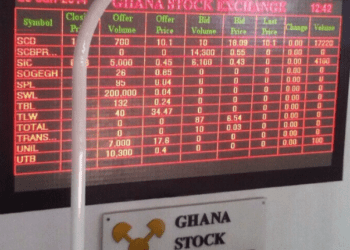The Bank of Ghana has reported a steady climb in its gold holdings, with reserves reaching 34.40 tonnes in July 2025, marking a 4.09% increase from the previous month.
The latest figures highlight the central bank’s ongoing strategy to build a stronger, more diversified reserve base as part of efforts to shield the economy from external shocks.
According to official data, Ghana’s gold reserves have risen by 8.05% since the start of the year, when they stood at 32.99 tonnes.
This consistent growth is the product of an aggressive gold accumulation drive that began at 30.53 tonnes in January and has since recorded monthly gains.
“The gold accumulation programme is an essential tool in our efforts to diversify reserve assets, reduce exposure to global financial volatility, and provide the economy with more robust buffers against external shocks.”
Bank of Ghana
The push to strengthen gold reserves has been a deliberate policy shift in response to both domestic and global economic pressures.

From as low as 8.78 tonnes in May 2023, the Bank of Ghana has more than quadrupled its holdings in just over two years.
Officials attribute this growth to the Domestic Gold Purchase Programme, a cornerstone initiative designed to boost foreign exchange reserves, stabilise the cedi, and improve the country’s attractiveness to investors.
By purchasing gold directly from domestic producers, the central bank has been able to limit its reliance on volatile external debt markets.
The policy also supports Ghana’s mining sector, reinforcing the nation’s status as Africa’s leading gold producer. This, in turn, enhances Ghana’s leverage in global commodity markets while ensuring that more value from its mineral wealth is retained within the economy.
Analysts note that the strategy is part of a broader macroeconomic stabilisation effort, complementing other initiatives such as the Gold for Reserves and Gold for Oil programmes.
These policies, introduced in mid-2023, have allowed Ghana to exchange gold for essential imports like petroleum products, reducing the country’s dependence on scarce foreign currency reserves.
Gold Boosts Stability

The accumulation drive is also seen as a factor in the relative stability of the cedi in 2025, even as many emerging market currencies have struggled under the weight of rising global interest rates and shifting investor sentiment.
The central bank has highlighted the broader economic benefits of its gold acquisition strategy. By leveraging gold holdings to secure affordable financing, Ghana can meet short-term foreign exchange needs without taking on excessive new debt.
This aligns with the government’s wider goal of reducing debt vulnerability while maintaining momentum in economic growth and industrialisation.
With the July accumulation, Ghana now stands among African nations with significant official gold holdings, a status that could enhance its influence in global commodities negotiations and multilateral financial engagements.
The development reflects a growing recognition across the continent of gold’s strategic role in reserve management, particularly in an era of shifting trade patterns and currency realignments.

Looking ahead, market observers expect the Bank of Ghana to maintain its current accumulation pace, especially if global economic conditions remain unpredictable.
The central bank’s challenge will be to balance the benefits of higher gold reserves with the need for adequate liquidity in other reserve assets to meet immediate trade and debt servicing requirements.
Still, the sustained growth in Ghana’s gold holdings is being viewed as a strategic success, particularly given the starting point just two years ago.
It also underscores the effectiveness of the Domestic Gold Purchase Programme in aligning mineral resource management with macroeconomic stability goals.
With reserves at 34.40 tonnes and rising, Ghana’s gold strategy appears firmly on track to deliver both immediate currency stability and long-term economic resilience.
READ ALSO: Ghana Set to Smash All 2025 Economic Targets – IC Research Hails Strong H1 Performance



















